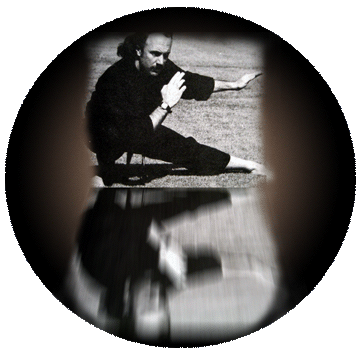
by
C. Alexander Simpkins Ph.D. & Annellen Simpkins Ph.D.

You stand, meditatively enjoying nature and the evening, calm, tranquil and at peace. Suddenly, attacked from behind,you find yourself thrownto the ground by a mugger who now poises a boot to kick you in the face. How can Tae Chun Do get you out of this predicament? Impossible?
Your experience in Tae Chun Do has directly prepared you for a toe-to-toe confrontation, but now another situation is thrust upon you. In a street fight, it is common to be thrown and wrestled to the ground, pinned, kicked, choked or brutally beaten. It is vital to be able to deal with the potential menace of this kind of attack. Most Tae Chun Do techniques are best executed on two feet and at a leg or arms distance away from the target. But what are you to do if the opponent steps in and throws you to the ground? If you have studied and practiced ground fighting, you will be able to deal with the situation.
Groundwork is implicit in many of the Tae Chun Do forms and moves, but you may never have thought of them in this way. This article will point out some basic principles and help you add goundwork to your repertoire.
All martial arts styles have their own fundamental stances, blocks and attacks upon which the system is based. Many of these same basic principles can be extended and applied to groundwork. Even though at first the moves may feel foreign and awkward due to the position, you can use the many skills you have developed coupled with diligent practice of ground fighting, to add a new realm to your Tae Chun Do.
A solid stance is the cornerstone of power, balance, and focus. How you stand has an effect on what you do, how you do it, and how much force you can exert in your techniques. This same logic applies to groundwork. Stances are equally important and even more varied than merely standing on two feet. Height of stance is a variable you can use to your advantage in groundwork. You can also vary combinations of hands, feet, knees and body as your main source of support. Here are four basic stance positions which offer a firm foundation for groundwork techniques. There are many other possibilities to experiment with on your own.
I. Crouching
|
Ground
stances most similar to standing stances are the crouching stances,
on both feet. All of your basic Tae Chun Do stances can be applied low
on the floor with some adjustments. These include the horse stance,
very deep back and front stances, and extended cat and X-stance.
|
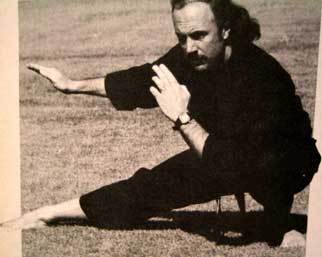 |
II. Low with hands
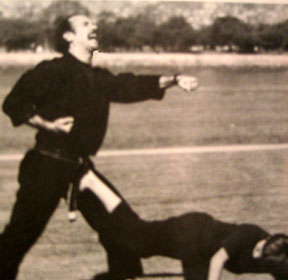 |
A second type of stance is done with on all fours or with one hand and two feet down. Hand-foot stances can be done with your head and body facing either up or down. These stances may mimic animal positions. Many kung fu styles draw directly from the movements and positions of animals. For example, Monkey Kung Fu imitates the posture of a monikey low to the ground, with arms dragging on the floor as support. Watch how animals move on all fours, leap up and down, or crouch. Animals can inspire you, but you do not have to be limited to imitating animals to create excellent ground fighting moves. A natural logic flows from your Tae Chun Do. |
III. Kneeling
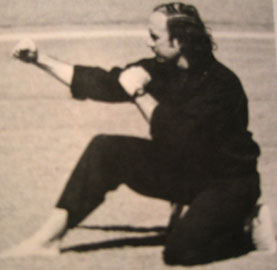 |
Kneeling
is another important resource for groundwork. Stances can be done on one
knee or both. With practice, these positions allow for a great deal of
mobility and speed. They can also be used as transition stances from standing
to lying down. Kicks such as roundhouse and spinning heel techniques can
easily be applied from this position. It is also easy to spring up or
back from the opponent.
|
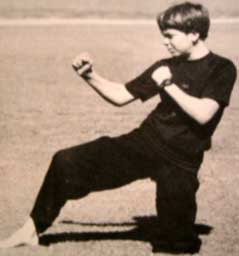 |
IV. Lying
| The lowest series of ground stances are done all the way down, sitting or lying on your side or back with hands flat on the floor for support. From variations at this position (hands behind and underneath) it is possible to scoot quickly towards or away from the opponent. | 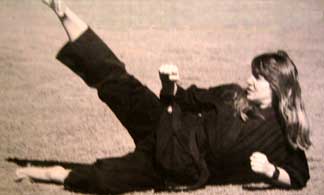 |
All of these stances make it possible for the practitioner to throw attacks, defend or perform takedowns which are tough to stop. Each type of stance will determine the kinds of techniques you can execute. For example, a scissors takedown can be done from lying on the floor. But a low cat stance supported by one or both hands or a kneeling stance on one knee lends itself better to crescent sweeps with the front or reversing back leg. A "groundhouse" (roundhouse kick from the floor) is easily done lying down from one knee, but is difficult from a low stance on both feet without a weight shift. Experiment with the different stances for what techniques follow most naturally. draw solidity and stability from the ground.
You will need to drop very quickly, almost like falling. The competent ground fighter must know how to avoid injury and be ready to fight. In a good fall you absorb the shock, usually by slapping as you go down, or at least relax, roll, and protect your head by tucking your chin. There are many variations. Refer to books on judo or jujitsu for more detail.
Economy of motion is another important principle for getting down efficiently. Use the most direct way onto the floor. For example, if you want to get down after a strong side kick, drop to the other knee and you will find yourself in the one-knee ground stance. Often, after you throw a strong offensive move, or your opponent commits fully to a high kick, you have that extra second to get down and ready yourself for groundwork. Duck under the high kick as you drop to the ground.
Equally important in effective to knowing how to get down fast is knowing when and how to get up, especially after you have dropped down for a ground technique. Unless you plan to bring your opponent down with you or fight entirely from the ground, you must be able to get up with your guardr eady. Try to get your opponent off-guard or moving back as you quickly rise to your feet. Do not fight gravity. Try to align your upper body and keep your head protected or away from the opponent. Bring your feet under and lift cautiously. You will find that you can rise easily. Practice getting down and up quickly and the motions will eventually feel natural.
Any system of martial arts is made up of a basic alphabet of movement in its kicks, blocks, and punches. Groundwork also contains its own elements: Kicks, blocks, takedowns, and punches.These draw from your style, but must be the lower angles to attack or defend, find the openings for hooks, sweeps, and other takedown maneuvers, as well as kicks, punches, and blocks. Techniques can be extremely forceful, since they draw solidity and stability from the ground. The block or strike can be timed to coordinate with downward or upward acceleration, so the bodyweight adds to the force of the block or attack.
KlCKS-- Ground kicks can be highly effective since the low angle of attack is difficult to block. Front, side, back, roundhouse and crescent kicks can all be readily thrown from the ground with some adjustment of technique. You can experiment with different starting positions. Try your kicks from one knee or lying on your side or back. Use one or both hands to brace yourself and kick a target pad or heavy bag placed on the floor.
BLOCKS-- Suppose you have been thrown to the floor and your attacker is getting ready to finish you off with a front kick. You need not feel defenseless from the ground. Many of the blocking principles which apply to upright sparring can be adapted for the floor. Both of your legs and arms can be used for blocks, grabs and traps. Leg maneuvers from the ground can be used as blocks or to attack the opponent's supporting leg as he kicks. Move in close and you can use your arms to block and grab. Remember that the level of stance gives you latitude with distance: Move in closer from the knees or dodge away on your back or side.
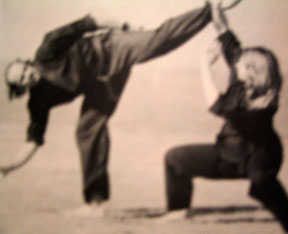 |
Distance and timing are essential elements in successful ground blocks. How you block can lead you into your next technique. For example, if the opponent kicks at your head when you are down, roll toward him and jam the kick vith a forearm block, then grab his supporting leg and follow through with a take down. |
Lying on the ground leaves your legs free for stop hits and traps. A stop hit interrupts the flow of the opponent's technique while he is in the process of executing it. Thrown from the ground, a stop hit is difficult for the opponent to deal with. For example, if a front kick comes in, drop down to a side lying position and fire a side kick to the opponent's supporting leg. This technique works as a stop hit by interrupting the opponent's flow which throws off his force and accuracy. Traps with the legs follow similar principles to traps with the arms when standing. Cross your legs around the opponent's supporting leg while he kicks and take him down with a scissors takedown.
Takedowns from the ground can be powerful and difficult to evade. Takedowns utilize leverage and the mechanical force principles of motion. Every force has an equal and opposite counterforce exerted by the object acted on. If you apply two equal and opposite forces in a scissors motion of the legs, the stable balance point between (the opponent's leg) becomes a fulcrum that he will rotate round. The opponent's stance is the reference point for the takedown. A standard front stance offers good weight distribution for a scissors takedown. Push with the upperleg, pull with the lower leg, while performing a similar leg motion to the side stroke in swimming. This sends the opponent toppling down.
When takedowns are applied, the balance of the opponent must be broken. Sudden attacks to the knee of the opponent, front, back or sideways can make him lose his balance. Many ground fighting takedown techniques use this as the entry point to drop the opponent. Hold firmly in one direction with a foot or hand while applying painful force on a pressure point. Push down or across with the foot or hand in an opposing direction and the opponent must go down. The opposing pressure can be applied with a strike, grab, push or sweep. Make certain that you hold firmly to prevent escape. Force can be applied in a simple rotational way. Move in close after a block to hook the opponent's ankle. Punch in the opposite direction to your hooking action and the opponent will be swept off his feet. This works best if you can make the opponent transfer his weight to the foot you have hooked.
Many years of practicing basics and forms have indirectly trained you for groundwork even though you may have never used these options. You will, however, need to practice actually from the ground, using forms. Pyong An 2 has many moves that may be adapted to sweeping and throwing. For example, a step in, followed by shifting back to a 90-degree angle with a pull across and down gives leverage advantage to throw the opponent after an offensive grab. Some of the later forms in the series have lapel grabs and head grabs. These moves can be used as takedowns if performed as a self defense move. Approach from behind the opponent and grab the hair, pulling down, followed by a front kick either to the back of the leg or lower back at the tailbone. This will drop the opponent down immediatly.
Black Belt form, Ship Su, has a series of moves that can be used as a sweep with a two-handed palm heel strke and shove to the ribcage and sternum: effective and painful. Tae Chun Do forms with a lower groin level horizontal spear thrust followed by a backfist can be used to take an opponent down. Grab behind the knees and pull out while pushing in the opposite direction with the other hand, causing the supporting knee to bend and thus, opponent drops.
You may want to go to the floor suddenly to elude a series of high, hard attacks when the attacker is clearly confortable and well-versed in upper target attacking. Tall or large attackers may find the sudden shift in defending positions difficult to deal with, awkward to reach at first with a punch or kick.
A ducking, weaving motion brings you forward and in close while in a low position. It is not far from there to the ground, to then attack the opponent's foundation. A quick change of height makes it possible to gain a downward acceleration. A high kick that is blocked upwards and eluded by the defender leads to a backward and downward force on the attacker as the equal and opposite reaction takes place. Full contact boxers often go down as they attack during matches.
Once you and your opponent are down, follow with a counterattack from the ground to the floored opponent's vulnerable areas, especially those nearest: feet, ankles, knees, groin and legs. Make sure the opponent cannotdr op on you when you attempt to grapple at close quarters. Attack instantly and be ready to use one or both legs to push the opponent away. Do not stop until submission is achieved. This is important in ground fighting and grappling. If the situation becomes a fight for your life, you must be aggressive and take control!
Takedowns can be resisted if you are able to prevent your balance from being broken. One way to evade a takedown is to go in the direction of the force while shifting balance. Then the application of a final drop maneuver becomes difficult. Another way to evade a takedown is to anticipate the action as you sense yourself dropping. Roll or drop quickly, then accelerate away from the opponent and withdraw. Alternatively you can turn the tables on the opponent by countering his attempted throw and sweep and to break his balance and make him fall.
When standing, footwork is used to ensure mobility. Similarly, patterns of motion on the ground can be accomplished by shifting weight to one hip and then the other, or using rolls combined with hand pushes in one direction to bring about the motion in the opposite direction. Ground fighting makes evident the laws of motion we mentioned earlier. If you push in one direction, there is an equal force in the opposite direction. If you hold one direction rigid and constant by bracing your hands as you push, the opposite tendency will push the opponent's body the other way. Remember also that a kick or punch from the floor will have an equal or opposite counterforce in the other direction, so brace yourself well if you kick hard. When you connect with an object, the equal-opposite force can push you backwards quite strongly. One of the basic principles of Tae Chun Do is balance and self-contained strength. This principle must be accounted for in groundwork as well.
The art of ground fighting shares common factors with many fighting arts such as judo, jujitsu, kung fu, chin na, and even wrestling. Once thrown to the ground you may be called upon to use all of your resources. We have pointed to some possibilities for ground fighting, but there are many other techniques and principles involved. The reader is encouraged to be flexible and continue to learn and develop his or her skills in this area.
Earth is one of the four basic elements which makes up our unierse. In attuning yourself to the ground, you can get in touch with ancient sources of strength and support to expand yourself as a martial artist.
Back to Main Page / Interesting Links / Book Corner / Photos / Events / E-mail us